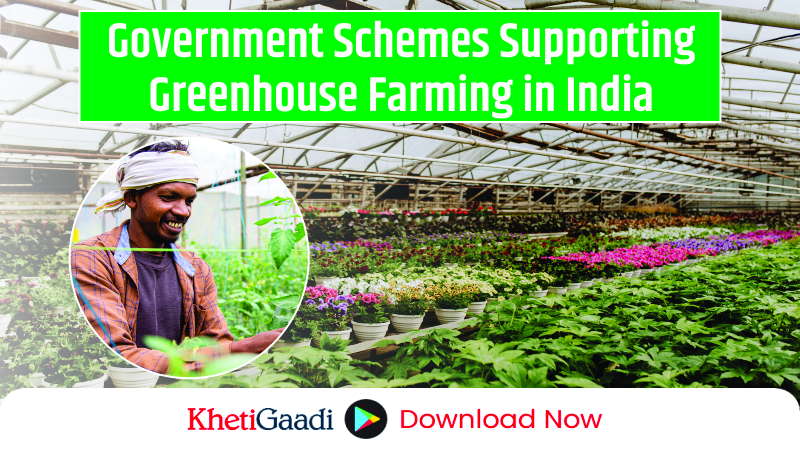Greenhouse farming, also known as protected cultivation, is gaining significant popularity in India as a modern and sustainable farming technique. As traditional farming faces challenges from climate change, resource depletion, and pest attacks, greenhouse farming offers a viable solution. By controlling environmental factors, greenhouse farming provides ideal conditions for crops to thrive, resulting in increased yields and profitability. In this blog, we will explore the various types of greenhouse farming, the benefits it offers, and how Indian farmers can take advantage of government schemes to boost their greenhouse operations. Additionally, we will look at a few success stories that highlight the potential of this innovative approach to farming.
What is Greenhouse Farming?
Greenhouse farming involves growing crops within a structure—typically made of glass, polycarbonate, or plastic—designed to create a controlled environment. This protective environment shields plants from extreme weather conditions, such as excessive heat, cold, rain, or wind, while regulating factors like temperature, humidity, light, and air circulation. By doing so, farmers can grow crops year-round and cultivate plants that otherwise may not thrive in certain climates.
Types of Greenhouse Farming
There are several types of greenhouses, classified based on the materials used, their structure, and the purpose they serve.
1. Based on Material
- Glass Greenhouses: These are traditional greenhouses made from glass panels. They offer high light transmission, making them ideal for crops requiring abundant sunlight. However, glass greenhouses are expensive to construct and maintain.
- Plastic/Polyethylene Greenhouses: More cost-effective than glass, plastic greenhouses are commonly used in India. They provide sufficient light transmission and are suitable for small to medium-scale farmers.
- Polycarbonate Greenhouses: These structures offer better insulation than plastic and are more durable, making them suitable for areas with harsh weather conditions.
2. Based on Structure
- Ridge and Furrow Greenhouses: In this type, multiple greenhouses are connected at the ridge to form a continuous structure. This reduces heat loss and improves efficiency.
- Gable Roof Greenhouses: These have a triangular roof and are commonly used for growing tall plants.
- Quonset Greenhouses: Characterized by their curved roof, these are easy to construct and maintain, making them a popular choice for small farms.
3. Based on Environmental Control
- Low-Cost Greenhouses: These rely on natural ventilation and low-cost materials, making them affordable but less efficient at controlling the internal environment.
- Climate-Controlled Greenhouses: Equipped with heating, cooling, and ventilation systems, these greenhouses maintain precise environmental conditions. They are suitable for high-value crops but require a significant investment.
4. Based on Purpose
- Commercial Greenhouses: Designed for large-scale cultivation, these are typically used for producing vegetables, flowers, and other crops for sale.
- Research Greenhouses: Used by agricultural scientists to study crop growth, genetics, and pest resistance under controlled conditions.
Benefits of Greenhouse Farming
Greenhouse farming offers a range of benefits that make it an attractive option for farmers in India.
1. Extended Growing Seasons
In open-field farming, crop production is limited by seasonal variations. Greenhouse farming allows crops to be grown year-round, regardless of external weather conditions, leading to higher production rates.
2. Water Efficiency
Water is a critical resource in agriculture, and greenhouse farming promotes efficient water usage through drip irrigation and moisture control systems. This is particularly important in regions where water scarcity is a major issue.
3. Improved Crop Yields
Since greenhouses provide optimal growing conditions, crops tend to grow faster and healthier. The controlled environment also reduces the risks of pests and diseases, which typically affect crops in open fields.
4. Higher Quality Produce
Crops grown in greenhouses are usually of better quality, as they are less exposed to environmental stressors like pests, dust, and pollutants. This leads to higher market demand and better prices for farmers.
5. Pest and Disease Control
The enclosed environment of a greenhouse limits the exposure of crops to pests and diseases. Additionally, integrated pest management techniques can be used to monitor and control pests without harming the crops.
6. Efficient Land Use
Greenhouse farming allows for the cultivation of high-value crops on smaller land areas, making it an efficient option for farmers with limited land resources. Vertical farming techniques can also be integrated within greenhouses to further optimize space.
7. Climate Resilience
India’s agriculture is highly susceptible to climate changes, which can cause unpredictable rainfall, heatwaves, and droughts. Greenhouses protect crops from these weather anomalies, ensuring stable production throughout the year.
Profitability of Greenhouse Crops
The profitability of greenhouse farming depends on the type of crop grown and the level of investment in the greenhouse structure. Here’s a table showcasing the types of crops and their profitability:
| Crop | Average Yield (per acre) | Average Market Price (per kg) | Estimated Profit (per acre per season) |
| Tomatoes | 30-35 tons | ₹25-₹40 | ₹7-₹10 lakhs |
| Bell Peppers | 20-25 tons | ₹40-₹60 | ₹8-₹12 lakhs |
| Cucumbers | 25-30 tons | ₹20-₹35 | ₹6-₹8 lakhs |
| Roses (Flowers) | 1-1.5 lakh stems | ₹2-₹5 (per stem) | ₹3-₹4.5 lakhs |
| Strawberries | 7-10 tons | ₹150-₹250 | ₹10-₹15 lakhs |
Government Schemes Promoting Greenhouse Farming in India
To promote greenhouse farming and make it accessible to more farmers, the Indian government has introduced several schemes and subsidies:
1. National Horticulture Mission (NHM)
Under this scheme, the government provides subsidies for setting up greenhouses. The subsidy can range from 50% to 75% of the project cost, depending on the state and the farmer’s category (small, marginal, etc.).
2. Pradhan Mantri Krishi Sinchai Yojana (PMKSY)
This scheme promotes efficient water usage through micro-irrigation systems such as drip and sprinkler irrigation. Farmers setting up greenhouses can avail financial assistance to install these systems.
3. Mission for Integrated Development of Horticulture (MIDH)
MIDH offers financial assistance for constructing greenhouses, promoting horticulture, and adopting new technologies. The support includes funding for various greenhouse structures based on farmer needs.
4. Subsidies from State Governments
Many state governments, including Gujarat, Maharashtra, and Karnataka, provide additional subsidies for greenhouse farming under state-specific schemes.
Greenhouse Farming Success Stories
1. Suresh Kumar, Haryana
Suresh Kumar, a farmer from Haryana, switched to greenhouse farming after facing repeated crop failures due to unpredictable weather. He started with 2 acres of tomatoes in a polyhouse and now earns over ₹15 lakhs annually. His success has inspired other farmers in his village to adopt greenhouse farming.
2. Padmaja Reddy, Telangana
Padmaja Reddy, a progressive farmer from Telangana, began cultivating exotic vegetables like bell peppers and zucchini in a climate-controlled greenhouse. With proper training and government subsidies, she was able to quadruple her income within three years. Today, she supplies premium vegetables to high-end supermarkets in major cities.
3. Sanjay Patel, Gujarat
Sanjay Patel, a rose farmer from Gujarat, took advantage of the National Horticulture Mission’s subsidies to set up a greenhouse for cultivating roses. His flowers now fetch premium prices in both domestic and international markets, earning him more than ₹5 lakhs annually from just 1 acre of land.
Conclusion
Greenhouse farming is revolutionizing agriculture in India by enabling farmers to grow high-quality crops, increase their yields, and generate higher profits. With various types of greenhouses available and government schemes to support this shift, Indian farmers have an opportunity to embrace this technology and secure their future against the uncertainties of traditional farming. By investing in greenhouse farming, farmers can not only improve their income but also contribute to the country’s food security.
Reference Links
- National Horticulture Mission
Tags



